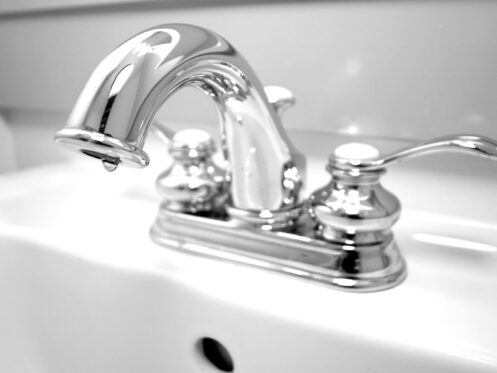A leaky faucet can be a nuisance and a waste of water and money. According to the Environmental Protection Agency, a faucet that drips at one drip per second can waste more than 3,000 gallons of water a year. That is enough water to take more than 180 showers!
Leaky faucet repair can sometimes be less complex than it looks. In this article, we will show you some common reasons why faucets leak, simple checks and ideas to fix them, and when you need to call a professional in the Glendale, AZ, area for help.
Why Do Faucets Leak?
There are many possible causes of a leaky faucet, but here are the most common ones:
Worn-out Washers
Washers are rubber or plastic discs that seal valves and prevent water from flowing when the faucet is off. Over time, they can wear out, crack, or loosen, causing water to drip from the faucet spout or handle.
Damaged or Corroded Valve Seat
This is the section of the faucet that connects the spout and the faucet stem. Damage can occur from water sediments, minerals, or rust. This damage will cause leaks around the spout.
Faulty O-ring
This part is a little, o-shaped, rubber ring that fits around the faucet stem. It keeps the handle securely in place. If the O-ring is worn out, broken, or missing, you can expect to see water leaking around the handle.
Loose or Broken Parts
Sometimes, a faucet may leak due to loose or broken parts, such as the packing nut, the stem, the cartridge, or the aerator. These parts can become damaged or loose by frequent use, improper installation, or water pressure.
Tools and Faucet Types
Before you start fixing your leaky faucet, you will need some tools and supplies, such as:
- Adjustable wrench
- Screwdriver
- Pair of pliers
- Cloth or rag
- Plumber’s tape or thread sealant
- Replacement washer, O-ring, cartridge, or other parts
You will also need to identify your faucet type, as different faucets have different mechanisms and parts. The most common types of faucets are:
Compression Faucet
This is the oldest and least complex type of faucet. It has two handles, one for hot water and one for cold. Each handle has a washer that compresses against a valve seat to control the water flow.
Ball Faucet
This is a single-handle faucet with a ball-shaped cap and a metal or plastic ball inside the faucet body. The ball has slots that align with the hot and cold water inlets and the faucet spout, allowing water to flow after turning the handle.
Cartridge Faucet
This is a single-handle faucet with a cartridge inside the body. The cartridge has holes that align with the water inlets and spout. A stem also connects to the handle. The handle moves the cartridge up and down or side to side to control the water flow and temperature.
Ceramic Disc Faucet
This is a newer and more durable type of faucet with a ceramic disc cartridge inside the faucet body. The cartridge has two ceramic discs that slide against each other, creating a seal that’s watertight. The handle moves the upper disc to align the holes with the water inlets and the spout, allowing water to flow.
Steps to Fixing a Leaky Faucet
Once you have the tools and supplies ready and know your faucet type, you can try to fix your leaky faucet.
Please understand that people who attempt DIY plumbing repairs often make problems worse. A botched DIY repair will ensure a professional has to charge even more. Contact a professional plumber before attempting repairs yourself.
Here are the basic steps for leaky faucet repair:
Shut Down the Faucet Water Supply
Find the shutoff valves underneath your sink and twist them clockwise to stop the water flow to the faucet. If you can’t find the shutoff valves, you may need to shut off the water’s main supply to your house. Then, turn on the faucet to drain any remaining water and relieve the pressure.
Remove the Faucet Handle
Depending on the faucet type you own, you’ll need to take off a decorative cap, a screw, a nut, or a clip for handle access. Use your screwdriver, wrench, or pliers to loosen up and take off the handle. Be careful not to damage the finish of the faucet. Wrap a cloth or rag around the parts before using the tools.
Inspect and Replace the Faulty Part
Once you have removed the handle, you will see the stem, cartridge, ball, or ceramic disc, depending on your faucet type. Look for indications of damage on the part and the surrounding area. If you see any, replace the part with a new one that matches the size and model of your faucet. Replacement may also be needed for the washer, O-ring, or valve seat if they are worn out or damaged. To remove and replace the part, you may need a special tool that comes with the replacement kit. Make sure to apply some plumber’s tape or thread sealant to the threads of the part before installing it to prevent leaks.
Reassemble the Faucet
After you have replaced the faulty part, you can put the faucet back together by reversing the steps you took to remove the handle. Make sure to tighten all the parts securely but not too much to avoid damaging them. Turn the water supply back on, and test if the faucet still leaks. If it does, repeat these steps, or try a different solution.
DIYers Beware
When you first notice a faucet leak in your home, your first instinct might be to fix things yourself. The job might look easy, but appearances can be deceiving. If you’re dealing with a simple clogged drain, attempting to remedy the problem is probably safe. What about when it involves a leak? That can end in disaster.
When fixing leaks, making a single, minor mistake in the process can make the problem much worse. Even if it looks like it worked, you might come home to water gushing all over your floors the next day. Now you have to worry about the leak and any water damage in the room. Additionally, using the wrong tool or improperly using the right tool can be dangerous. You may make the leak worse or hurt yourself.
Don’t risk damaging your home or jeopardizing your safety. Consulting with a professional is the best solution in most situations.
When You Need to Call for Professional Help
While fixing a leaky faucet yourself appears to save you some money and time, it can end in disaster. Sometimes, the problem may be more complex than you think, and you may end up causing more damage or wasting more money. Here are some situations when you need to contact a professional plumber for help:
- No tools or supplies
- Don’t know the faucet type
- Can’t find the cause of the leak
- Repair attempt doesn’t work
- Leak is too severe
- Faucet is old or damaged beyond repair
- Faucet upgrade desired
A professional plumber has the skills, experience, and equipment to handle any faucet problem, big or small. They can diagnose the issue, provide the best solution, and ensure the quality and safety of the repair. They can also advise you on faucet maintenance to prevent future leaks.
A leaky faucet is not only annoying but also wasteful and costly. Don’t hesitate to contact a local plumber for help. Christian Brothers Air Conditioning Plumbing Electrical services Glendale and the surrounding areas. We offer plumbing, cooling, heating, and electrical services. We will repair your faucet quickly and efficiently, giving you peace of mind. Contact Christian Brothers Air Conditioning Plumbing Electrical today.










